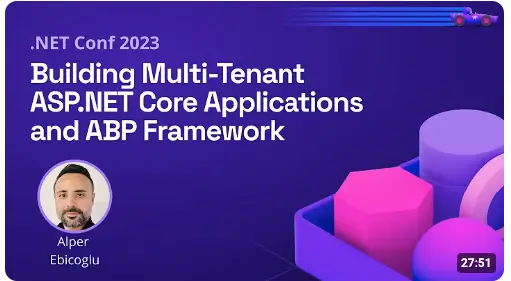Mastering Multi-Tenancy in ASP.NET Core: Real-World Insights
An In-Depth Guide to Multitenant ASP.NET Core Application Development with the ABP Framework
Introduction
Multitenant applications have become a standard architecture in enterprise software, offering scalability, cost efficiency, and streamlined maintenance. In this article, we'll delve into the essentials of multitenancy within the ASP.NET Core ecosystem, focusing on the capabilities of the ABP Framework. Through this guide, you'll gain insights from Alper—a co-founder of Volosoft, which specializes in frameworks and tools for .NET developers. Alper shares real-world experiences and implementation strategies to help you master multitenant development.
What Is the ABP Framework?
The ABP Framework is an open-source, modular, and microservice-compatible framework built on ASP.NET Core. It provides a robust architecture for developing enterprise-level applications. Among its many features like exception handling, caching, and validation, it excels in multitenancy. This makes it an excellent choice for projects requiring data and application separation across multiple tenants.
Advantages of Multitenancy
Cost Efficiency
Sharing hardware and software resources among customers significantly reduces costs. A single codebase and infrastructure mean that all tenants can receive updates and improvements simultaneously, streamlining maintenance.
Simplified Maintenance
Maintaining a solitary codebase and infrastructure minimizes the complexity of software updates, patches, and bug fixes. Developers and administrators find it easier to manage a unified system, reducing the potential for errors.
Scalability
The ability to quickly increase system resources by adding extra servers behind a load balancer facilitates better resource utilization and responsiveness to demand spikes.
Ease of Deployment
New tenants can be onboarded rapidly within the existing infrastructure. Adding a new tenant often involves merely inserting a new entry into the tenants table, making the process straightforward.
Challenges of Multitenancy
Data Isolation
Ensuring proper data isolation is critical to prevent unauthorized access.
Customization
Clients may request customized applications, mandating different configurations and UI changes like logos and color schemes without compromising the core architecture.
Noisy Neighbors
The term "noisy neighbors" refers to tenants that heavily utilize system resources, potentially affecting the performance of other tenants. Monitoring and management are essential to mitigate this issue.
Security
A security breach can expose the data of multiple tenants. Hence, implementing robust security measures is crucial.
Backup and Recovery
Backing up and restoring data can be complex, especially if multiple tenants share the same database. Different tenants may also have distinct retention policies, necessitating varied backup strategies.
Multitenant Deployment and Database Scenarios
On-Premise
This model is least suited for SaaS, where the application and database are deployed on the clients' infrastructure.
Shared Application, Separate Databases
While this model is better for resource utilization, it can be difficult to migrate all databases simultaneously.
Shared Application and Database
This is a cost-effective model ideal for SaaS, where both the application and database server are shared among tenants.
Hybrid Approach
This model allows for the separation of databases for specific clients, such as banks and government agencies, who require isolated environments.
Managing Tenant Information
Identifying the Current Tenant
In the ABP Framework, there are multiple approaches to identify the active tenant:
- Authentication Ticket: Store the tenant ID in claims when a user logs in.
- Query String: Use URL parameters like tenant ID.
- Route Data: Embed the tenant ID or name in the URL.
- HTTP Headers: Useful for single-page applications and mobile clients.
- Cookies: Store the tenant ID similarly to HTTP headers.
- Custom Domain/Subdomain: Provide custom domains for tenants, which can be parsed from the request host value.
Ensuring Data Isolation
Using tenant IDs across all queries can be error-prone. The ABP Framework provides an interface called IMultiTenant to automate this, ensuring tenant IDs are consistently managed. Global query filters in EF Core can also be used to define conditions automatically applied to all queries, enforcing isolation.
Tenant Data Isolation with Interfaces and Global Filters
The ABP Framework leverages the IMultiTenant interface, making tenant ID a standard field across entities. Using EF Core's global query filters, tenant IDs are automatically handled, reducing the risk of human error. While this method is efficient, it may not support stored procedures or other ORMs.
Setting the Tenant ID Automatically
The ABP Framework uses an abstract class called Entity. By setting the tenant ID in the framework using reflection, tenant information is auto-populated, eliminating manual intervention and potential errors.
Connection String Selection
Managing multiple databases for tenants requires dynamic connection string selection. The ABP Framework maintains connection strings in a specific table. It first checks this table, then the microservices connection strings in the appsettings.json file, and finally falls back to the main application's connection string if neither of the first two options is available.
Changing the Active Tenant
Sometimes you need to switch between tenants, such as for background jobs generating tenant-specific reports. The framework uses a disposable action to temporarily change the tenant context. This ensures that operations are performed for the correct tenant and the context is restored after the operation.
Disabling Multitenancy
In certain scenarios, such as generating cumulative reports, you may need to disable multitenancy. The ABP Framework allows specific filters to be disabled, enabling you to query across all tenant data when necessary.
Managing Database Migrations
Migrating databases in a multitenant application can be challenging. Approaches include:
- Bulk Migration: Migrating all tenant databases simultaneously. Though simple, this can be time-consuming and affect availability.
- User-Triggered Migration: Initiating migrations when a tenant's user logs in or accesses the system. This isolates the migration impact but introduces potential latency.
- Staggered Rollout: Maintain multiple application servers with different versions. Tenants are gradually migrated to the new version, improving availability and enabling AB testing.
Conclusion
Multitenant applications are essential for modern, scalable, and efficient enterprise solutions. The ABP Framework in ASP.NET Core provides a robust foundation for developing such applications, from data isolation and dynamic connection management to seamless tenant migrations. By leveraging these tools and strategies, you can effectively manage and scale your multitenant applications, ensuring optimal performance and security for all tenants. For those interested in diving deeper, the ABP Framework's open-source resources are a valuable asset.

.webp)

